
The London, Chatham and Dover Railway was a railway company in south-eastern England created on 1 August 1859, when the East Kent Railway was given parliamentary approval to change its name. Its lines ran through London and northern and eastern Kent to form a significant part of the Greater London commuter network. The company existed until 31 December 1922 when its assets were merged with those of other companies to form the Southern Railway as a result of the grouping determined by the Railways Act 1921. The railway was always in a difficult financial situation and went bankrupt in 1867, but was able to continue to operate. Many of the difficulties were caused by the severe competition and duplication of services with the South Eastern Railway (SER). However, in 1898 the LCDR agreed with the SER to share the operation of the two railways, work them as a single system and pool receipts: but it was not a full amalgamation. The SER and LCDR remained separate companies with separate shareholders until both becoming constituents of the Southern Railway on 1 January 1923.
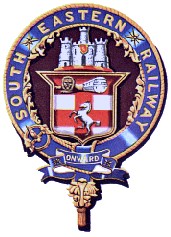
The South Eastern Railway (SER) was a railway company in south-eastern England from 1836 until 1922. The company was formed to construct a route from London to Dover. Branch lines were later opened to Tunbridge Wells, Hastings, Canterbury and other places in Kent. The SER absorbed or leased other railways, some older than itself, including the London and Greenwich Railway and the Canterbury and Whitstable Railway. Most of the company's routes were in Kent, eastern Sussex and the London suburbs, with a long cross-country route from Redhill in Surrey to Reading, Berkshire.

Strood railway station serves the town of Strood in Medway, England. It is on the North Kent Line and is also a terminus of the Medway Valley Line. It is 31 miles 11 chains (50.1 km) down the line from London Charing Cross.

The Chatham Main Line is a railway line in England that links London Victoria and Dover Priory / Ramsgate, travelling via Medway.

Chatham railway station is on the Chatham Main Line in England, serving the town of Chatham, Kent. It is 34 miles 25 chains (55.2 km) down the line from London Victoria and is situated between Rochester and Gillingham.

Sole Street railway station is on the Chatham Main Line in England, serving the village of Sole Street, near Cobham, Kent. It is 26 miles 71 chains (43.3 km) down the line from London Victoria and is situated between Meopham and Rochester. The station is managed by Southeastern.

Meopham railway station is on the Chatham Main Line in England, serving the village of Meopham, Kent. It is 25 miles 76 chains (41.8 km) down the line from London Victoria and is situated between Longfield and Sole Street. The station is managed by Southeastern.
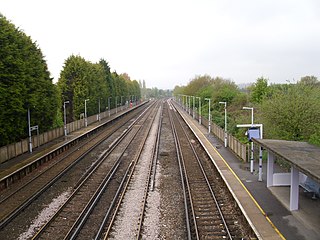
Newington railway station is on the Chatham Main Line in England, serving the village of Newington, Kent. It is 41 miles 44 chains (66.9 km) down the line from London Victoria and is situated between Rainham and Sittingbourne.

Teynham railway station is on the Chatham Main Line in England, serving the village of Teynham, Kent. It is 47 miles 74 chains (77.1 km) down the line from London Victoria and is situated between Sittingbourne and Faversham.
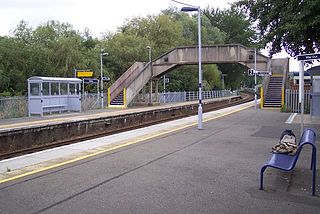
Chilham railway station is a railway station in Chilham, Kent. It is on the Ashford to Ramsgate line between Ashford International and Canterbury West. The station, and all trains serving it, are operated by Southeastern.
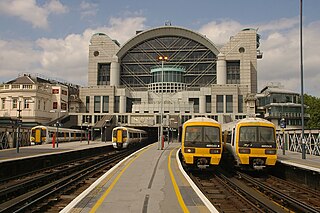
The South Eastern Main Line is a major long-distance railway route in South East England, UK, one of the three main routes crossing the county of Kent, going via Sevenoaks, Tonbridge, Ashford and Folkestone to Dover. The other routes are the Chatham Main Line which runs along the north Kent coast to Ramsgate or Dover via Chatham and High Speed 1 which runs through the centre of Kent to the coast at Folkestone where it joins the Channel Tunnel.
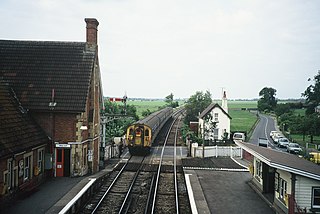
The Ashford–Ramsgate line is a railway that runs through Kent from Ashford to Ramsgate via Canterbury West. Its route mostly follows the course of the River Great Stour.
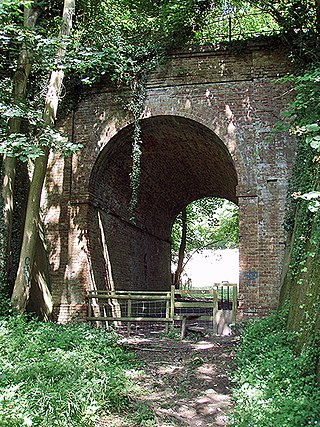
The Elham Valley Railway was a line connecting Folkestone and Canterbury in Kent, England. It opened between 1887 and 1889 and closed in 1947.
Transportation needs within the county of Kent in South East England has been served by both historical and current transport systems.

Reading Southern railway station is a former railway station in Reading, Berkshire, England, located to the south of Reading General station on the Great Western main line.
James I'Anson Cudworth was an English railway engineer, and was Locomotive Superintendent of the South Eastern Railway (SER). He served in this capacity from 1845 to 1876. He is notable for designing a successful method for burning coal in steam locomotives without significant emission of smoke, and for introducing the 0-4-4T wheel arrangement to English railways.
The Mid Kent & North Kent Junction Railway was an early railway in Kent England.
The LCDR Sondes class was a class of six steam locomotives of the 4-4-0ST wheel arrangement. They were designed by Thomas Russell Crampton for the East Kent Railway (EKR) to specifications prepared by Joseph Cubitt. An order was placed in March 1857 with R. & W. Hawthorn & Co. for six locomotives at £2,700 each; they were delivered to the EKR between November 1857 and March 1858. The first section of the EKR opened on 25 January 1858; and the EKR became the London, Chatham and Dover Railway (LCDR) in 1859. The locomotives were prone to frequent failure: at one point, before the sixth had been received, the first five were all out of service simultaneously. The LCDR asked Daniel Gooch of the Great Western Railway to report on the condition of the locomotives; he found that there were a number of significant problems with the design. The Sondes class were all laid aside as unfit for use in mid-1863, and during 1865, all six were rebuilt by the LCDR as 2-4-0T, becoming the Second Sondes class.

Bricklayers Arms was a railway station in Southwark opened by the London and Croydon Railway and the South Eastern Railway in 1844 as an alternative to the London and Greenwich Railway's terminus at London Bridge. The station was at the end of a short branch line from the main line to London Bridge and served as a passenger terminus for a few years before being converted to a goods station and engineering facility. The goods station closed in 1981.

Canterbury Parkway railway station is a proposed interchange between the Ashford–Ramsgate line and the Chatham Main Line near Canterbury, Kent.
















